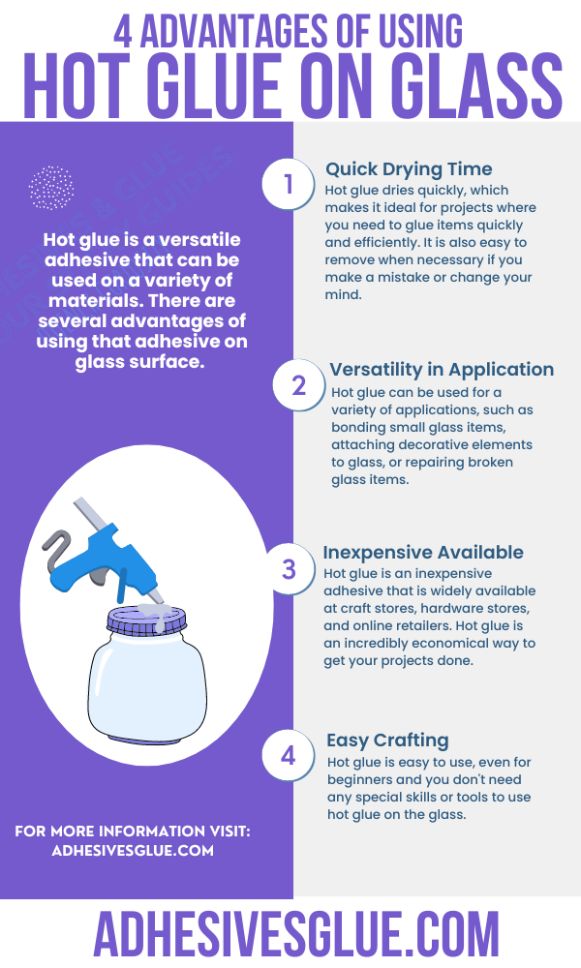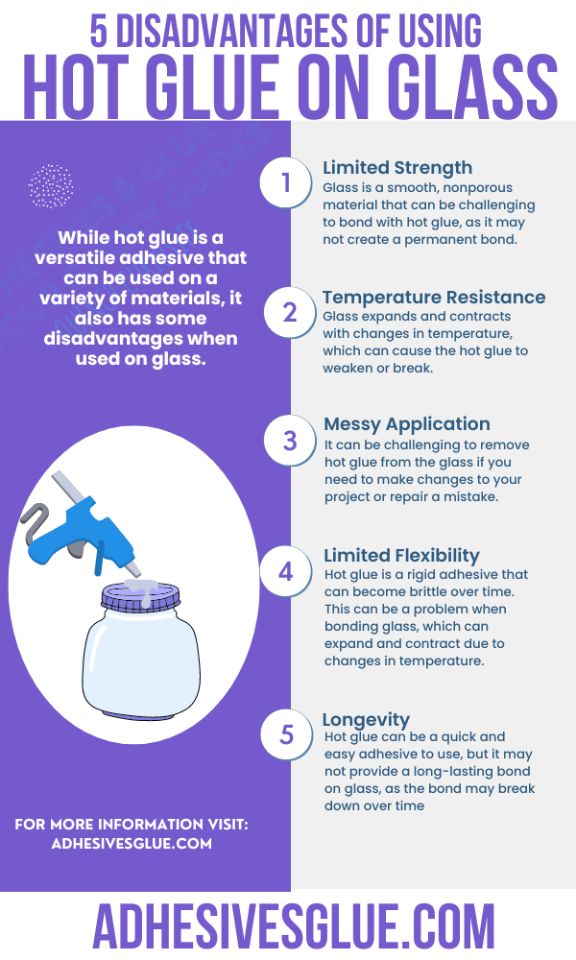If you are a crafter or a DIY enthusiast, you may have wondered whether it is possible to use hot glue on the glass. The answer is yes, you can use hot glue on glass, but there are certain tips and tricks you should keep in mind to ensure a strong and lasting bond.
In this post, we will discuss the advantages and disadvantages of using hot glue on glass. We will also tell you the steps you can follow if you want to create something cute or amazing.
Contents
4 Advantages of Using Hot Glue on the Glass:
There are several advantages of using hot glue on glass. Let’s take a look at the top 4.

1. Quick Drying Time:
Hot glue dries quickly, which makes it ideal for projects where you need to glue items quickly and efficiently. It is also easy to remove when necessary if you make a mistake or change your mind.
However, it’s important to read the labels of each particular type of hot glue before starting your project to ensure that it is best suited for the glass surface material and items you are attaching.
2. Versatility in Application:
Hot glue can be used for a variety of applications, such as bonding small glass items, attaching decorative elements to glass, or repairing broken glass items. With careful application, hot glue can be used to bond delicate items, like jewelry and ornaments without fear of them being damaged.
For example, if the handle of a glass, vase or other item breaks off, you can easily fix it by attaching the handle with hot glue. Finally, you can even use hot glue to create DIY crafts and decorations on your glass surface by forming shapes or designs.
3. Inexpensive and Widely Available:
Hot glue is an inexpensive adhesive that is widely available at craft stores, hardware stores, and online retailers. Hot glue is an incredibly economical way to get your projects done.
Not only is it easy to find, but it typically costs just a few dollars per bottle or stick. As such, you can purchase enough glue to last the entire project without needing to break the bank.
Plus, if you purchase hot glue online, you can often find even better prices and an even larger selection of products.
4. Easy Crafting:
Hot glue is easy to use, even for beginners and you don’t need any special skills or tools to use hot glue on the glass.
Hot glue is an incredibly user-friendly adhesive. All you need to do is apply the glue in a thin layer on the surface you are working with and press down firmly for a few seconds for a secure bond. It dries quickly, so you don’t have to wait long between steps either.
And in most cases, if needed, you can easily remove the hot glue from surfaces without causing any damage or leaving behind any residue.

5 Disadvantages of Using Hot Glue on Glass:
While hot glue is a versatile adhesive that can be used on a variety of materials, it also has some disadvantages when used on glass. In this section, we will discuss some of the disadvantages of using hot glue on glass.
1. Limited Strength:
While hot glue can create a strong bond on some materials, it may not be the best choice for bonding glass. Glass is a smooth, nonporous material that can be challenging to bond with hot glue, as it may not create a permanent bond. This is especially true for items that will be subjected to stress or weight, such as hanging wall decorations or furniture.
2. Poor Resistance to Temperature Changes:
Glass expands and contracts with changes in temperature, which can cause the hot glue to weaken or break. If you are using hot glue to bond items that will be subjected to temperature changes, such as outdoor decorations or items that will be used in the kitchen, it may not be the best choice.
3. Messy Application:
Hot glue can be messy, and if you apply too much of it, it can be difficult to clean up. It can also be challenging to remove hot glue from the glass if you need to make changes to your project or repair a mistake.
4. Limited Flexibility:
Hot glue is a rigid adhesive that can become brittle over time. This can be a problem when bonding glass, which is a material that can expand and contract due to changes in temperature or pressure. The rigidity of hot glue can cause the bond to weaken or break over time, especially if the item is subjected to stress or movement.
5. Longevity:
While hot glue can be a quick and easy adhesive to use, it may not provide a long-lasting bond on glass. The bond may break down over time due to factors such as temperature changes or exposure to moisture.

3 Steps for Using Hot Glue on Glass:
If you want to use hot glue on glass, here are some tips you should keep in mind:
1. Preparing the Surface:
Before applying hot glue to glass, it is essential to ensure that the glass surface is clean and free of any dirt, dust, or grease. You can use rubbing alcohol to clean the glass surface before applying the hot glue.
After cleaning the glass, it is important to allow the surface to completely dry before applying the hot glue. If you begin to apply the glue while any moisture is still present, it might not adhere properly and could even cause cracks in the glass.
Once you have ensured that the glass is completely dry, you can then begin to apply the hot glue directly to the surface.
2. Choosing the Right Hot Glue Gun and Glue Stick:
It’s important to use a high-temperature hot glue gun and a high-temperature glue stick when bonding glass with hot glue. This will provide a stronger bond than using a low-temperature glue.
When applying hot glue to glass, it’s important to use a slow and steady motion. This will help to prevent any air pockets or uneven surfaces from forming as you apply the glue. Try to avoid applying too much pressure when pressing the glue stick into the surface of the glass.
This could cause cracks or weaken the bond between the glass and the adhesive. Finally, once you have finished applying the hot glue, be sure to allow it to cure for at least 12 hours before using it for its intended purpose.
3. Applying Hot Glue on Glass:
To ensure a strong bond, apply small amounts of hot glue to the glass and press the materials together firmly for a few seconds. Avoid applying too much glue, as it can create a mess and may not bond as well.
Make sure to wait a few minutes between each application of glue. This will give the adhesive time to cool down and prevent heat damage to the materials you are bonding together. Also, when possible, apply hot glue to both surfaces before pressing them together to ensure an even bond between the two materials.
Finally, use a damp cloth or paper towel to clean up any excess glue that may have seeped out when bonding the materials.
Safety Tips:
When using hot glue on glass, it’s important to take safety precautions to avoid burns or other injuries.
- Use the glue gun carefully, avoiding touching the hot glue, and keep it out of reach of children.
- Use the glue gun on a heat-resistant surface and wear protective clothing, such as gloves, and safety glasses.
- Keep the area well-ventilated to prevent the buildup of fumes from the melting adhesive.
- Never leave the hot glue gun unattended, and make sure to unplug it or turn off the power when you are done using it.
- In case you are injured, immediately treat the burn.
Conclusion:
In conclusion, hot glue can be used on glass, but it’s essential to take precautions to ensure a strong and lasting bond.
By following the tips and tricks we discussed in this post, you can use hot glue on glass for a variety of projects, from home decor to repair projects, and more.
Remember to take safety precautions when using hot glue, and have fun experimenting with this versatile adhesive.

I fell in love with crafts & fixing things when I was 11 years old – after discovering the world of blogging, I am combining my passions to present the world with well-researched guides & reviews about everything related to adhesives & glue.